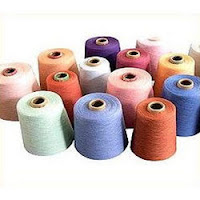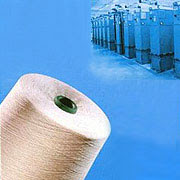What is Yarn Count & How It is calculated
Count is very important factor for the Textile YarnManufacturing. Maintaining the yarn count is mandatory to retain the quality of a yarn and fabrics. Now read the basic things about yarn count at below:

Definition of Count: According to the Textile Institute “Count is a number of indicating the mass per unit length or length per unit mass of yarn”.
There are several count system of yarn. These count systems have been divided in two ways. One is Direct System where length is fixed and another is Indirect system where weight is fixed.- Direct System (Length Fixed):
B). Denier: Weight of yarn in gm present in 9000 meter length. It is basically used for man made fiber.
C) Pounds Per Spindle: Weight of yarn in lbs present in 1440 yards length.
- Indirect System ( Weight Fixed):
B) Metric Count: No. of hanks of 1000 meters present in 1 kg of yarn.
C) Worsted count: No. of hanks of 560 yds present in 1 lb of Yarn. It is basically used for Wool.
Properties of Cotton Fibre that needed for cotton Spinning
The following properties a cotton fibre should have to contain of:-
1. Cotton Fibre Fineness:
Fineness is one of the most important parameter determining the yarn quality. This is the best cotton properties that almost all of the cotton importers wants. Cotton Fibre fineness influences the number of fibre in cross section. The finer fibre results the higher no. of fibre in yarn cross-sections. Fibre fineness influences primarily-a) Spinning limit. B) Lustre. C) Yarn Strength. D) Handle E) Yarn Evenness F) Productivity.
2. Fiber Maturity:
The maturity of cotton fibre defines in terms of the development of the cell wall. A fully mature fibre has a developed cell wall. On the other hand, an immature fibre has a very thin cell wall. A fibre is to be considered as mature fibre when the cell wall of moisture swollen fibre represents 50% to 80% of the round cross section, as immature fibre represents 30% to 45% and as dead when it represents less than 25%.Immature fibres lead to –a) napping b) loss of yarn strength c) high proportion of short fibre d) varying dyeability. So good cotton properties is to said as matured cotton fibre.
3. Fibre Length:
The average length of spinnable fibre is called staple length. Staple length is one of the most important fibre characteristics. The quality, count, strength, etc depend on the staple length of the fibre. Higher the staple length, higher the yarn quality. Staple length influences –a) yarn evenness b) lustre of the product c) spinning limit d) yarn strength e) yarn hairiness f) handle of the productThe following length grouping are currently used in stating the trade staple or basic cotton properties-
Short Staple: 1″ or less.
Medium Staple: 1 and 1/32 inch to 1 and 1/8 inch
Long Staple: 1 and 5/32 inch to 1 and 3/8 inch.
Extra Long Staple: 1 and 13/32 inch and above.
4. Cotton Fibre Strength:
Toughness of fiber has a direct effect on yarn and fabric strength. Cotton Properties means such type of physical behavior of a fibre. The higher the fibre strength, the higher the yarn and fabric strength. Very weak cotton tends to rupture during processing both in blow room and carding, creating short fibres and consequently deteriorate yarn strength and uniformity. Some significant breaking strength of fibres are-Polyester >>35 to 60 CN/Tex
Cotton>>>>15 to 40 CN/Tex
Wool>>>>12 to 18 CN/Tex
5. Cotton Fibre Cleanness:
In addition to usable fibre, cotton stocks contain various kinds of foreign matters. Some vegetable matters are- a) husk portion, b) seed portion c) stem portion d) leaf portion e) wood portion.Some mineral matters are- a) earth b) sand c) dust.
Some other foreign materials are- a) metal fragments b) cloth fragments c) packing materials.
6. Cotton Fibre Elongation:
Elongation is specified as a percentage of the starting length. Textile products without classify would hardly be usable. They must be deformed and also return to the original shape. The fibre elongation should be at least 1 to 2%. The greater crease resistance of wool compared with cotton arises due to difference in their elongation.What is Yarn Twist | S Twist | Z Twist | Amount of Twist
In belows, I have tried my best to discuss about the basic things of Yarn Twist.Yarn Twist:
Yarn Twist is the measure of the spiral given to a yarn in order to hold the constituent fibres or threads together.According to textile institute “Twist is the spiral disposition of the components of a thread which is usually the result of the relative rotation of the two ends”.
Types of Yarn Twist:
According to direction of twist, it is of two types: -1. S- Twist
2. Z- Twist.
S- Twist: A single yarn has S twist if, when it is held in the vertical position. The fibres inclined to the axis of the yarn conform in the direction by slope to the central portion of the letter “S”.
Z-Twist: A single yarn Z Twist if, when it is held in the vertical position, the fibres inclined to the axis of the yarn conform in the direction of slope to the central portion of the letter “Z”.
Amount of Yarn Twist:
The amount of twist in a thread means the number of turns of twist per unit length in the twisted condition.If “n” be the number of turns of twist in “l”( small l) inch of yarn, then the amount of twist will be T= n/l .
What are the assumptions of an Ideal Yarn Properties?
1. The yarn in circular in cross-section and is uniform along its length.
2. Yarn is composed of concentric layers of different radial.
3. Each fibre follows a uniform helical path around one of the concentric cylinder so that its distance from yarn axis remains constant.
4. A fibre at the centre will follow a straight line of the axis.
5. The axis of circular cylinders coir sides with yarn axis.
6. The number of filaments or fibres crossing the unit area is constant; that is the density of packing. Fibres in the yarn are constant throughout the model.
7. Every filament in the yarn will have the same amount of twist per unit length.
8. The yarn consists of very large number of filaments.
If the above mentioned yarn properties is absent on any yarn than the yarn should not be allowed on weaving to make fabric. Because it will not be able to give you a perfect weaving combination where the warp and weft yarn’s parameter is mandatory to be maintained.
Logic of Twist Contraction & Retraction factor of Textile Yarn
Twist Contraction or Textile Yarn:
Normally before twisting, yarn contains textile fibre individually in extended state. By twisting yarn is contracted and mass per unit length increases because when yarns are twisted, the fibres in the yarn have to follow a longer path for migration. For staple fibre yarn, this phenomenon is called contraction. For filament yarn this is called retraction.Contraction Factor:
Contraction factor indicates the factor by which the draft must be adjusted to prevent the twist contraction from decreasing the size or count of staple spun yarn.Contraction factor may be expressed as,
CY = Length of Zero Twist Yarn / Length of twisted yarn.
The contraction factor, which ranges from 1 for no contraction to infinity for contraction to zero length.
Retraction Factor of Yarn:
In represents the fractional decrease in length or increase in the linear density or twisting continuous filament yarns.Retraction factor is expressed as,
RY = Length of zero twisted yarn length/ Length of zero twit yarn.
What is Yarn Count |How to Find Out Direct, Indirect, Tex, Denier Count
Here is the process terms on how to find out a yarn count and the basic things of count:
Yarn Count:
Count is the numerical expression of coarseness or fineness of the yarn.Types of Yarn Count:
Count is basically two types- 1. Direct Count 2. Indirect Count.Direct Count:
In direct system length unit is fixed but weight unit is variable. In this system the weight of fixed length of yarn is calculated and expressed by different weiht unit especially gram. In this system yarn will be coarser if the number is increased. Direct system is classified normally into two- 1. Denier 2. Tex.Denier Yarn Count System:
In this system, the length of yarn is 9000 m. if weight of 9000 m length of yarn is 40 gram the count of that yarn will be 40 denier.Tex:
In tex system weight of 1000 m length of yarn is considered and expressed by gram. Such as, if weight of 1000m length of yarn is 20 gram, the count of that yarn will be 20 tex.Lbs/ Spindle:
Weight of 14,400 yds jute yarn is calculated and expressed by lbs. That means, if 14,400 yds jute yarn weight is 8 lbs, the count of that jute yarn will be 8 lbs/ spindle.Indirect Count:
In indirect system the count is classified into two groups. One is English cotton count system and another is Metric system.English Cotton Count System:
Here weight unit is fixed but length unit is variable. In this system the number of hank of 840 yds yarn in one lbs is the number of English cotton count. Higher the number of count, finer the yarn. the lower the number of count, the coarser the yarn. It is expressed by (Ne).Metric System:
In this count system number of hank of 560 yds yarn in one kg is the number of metric count. It is expressed by (Nm).Yarn Spinning Classes | How many types a yarn has?
1. Types of yarn on the basis of processing machines used in the ring processing line:
a) Carded Yarn.b) Combed Yarn.
2. Types of yarn on the basis of spinning machine/frame used-
a) Ring Yarnb) Rotor Yarn
c) Air-jet Yarn
3. According to raw materials-
a) Short Staple- Cotton, Wool.
b) Long Staple- Jute, Silk.
What is Spinning Yarn:
Yarn is the product of Spinning which is used to make fabric.What is Yarn Geometry, Classification & Designation
What is Yarn:
Yarn is a product of substantial length and relatively small cross-section consisting of fibres or filaments with or without twist. It is the long fine structures capable of being assembled or interlaced into such textile products as woven and knitted fabrics, braids, ropes, and cords.Classification of Yarns:
1. Single Yarn.a) Continuous Filament.
b) Spun Yarn. It can be two types. One is Homogeneous, another is Blended.
c) Modified Continuous Filament.
2. Multi-folded Yarn/ Ply Yarn.
3. Cabled Yarn.
4. Complex Yarn
5. Fancy Yarn.
Yarn Designation:
The factor which are required to express yarn structure and properties wholly, are called yarn designation.The factors of yarn designation are:-
1. Yarn Count / Linear Density.2. No. of Filaments.
3. Fibre Components.
4. No. of components in folding.
5. Direction & amount of twist.







Post a Comment
Your post is very elaborate and I learned a lot from it! I wonder if you want to know some information about Twist Tester in:
Twist Tester